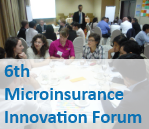- EN
- FR
- ES
Publications of 2014
2014 looks to be an interesting year for the Facility. With the end our first phase, the Facility is embarking on a new journey with a 5-year Quality at Scale programme, designed to reduce the vulnerability of 100 million low-income person.
Don't miss our exciting new publications throughout the year!
Microinsurance papers and briefing notes
In 2010 the Facility studied six insurers and saw that they were facing challenges with profitability. They implemented a number of corrective measures, particularly in distribution and claims management. Now, Business case for microinsurance part II: Follow-up study on the profitability of microinsurance investigates whether those measures have been successful over the longer term. (Angove, J.; Dalal, A.;3/2014) Key points of the paper are summarized in BN#26 (5/2014).
Based on a review of the experiences of insurance associations in five countries, Breaking the ICE: The role of insurance associations in insurance consumer education discusses the steps that should be taken during the preparation of developing an insurance consumer education programme. (Dalal, A.; Fonseca, C.; 3/2014)
Scale: Thinking big analysed 95 Initiatives that achieved scale and evaluated 8 case studies in detail to understand what drives scale. (Thom, M.; Gray, J.; Müller, M.; Leach, J; 3/2014). To learn more about the eight in depth case studies included in this paper, click here for Scale: Thinking big - Case studies Key points of the paper are summarized in BN#25 (3/2014).
Using subsidies for inclusive insurance: lessons from agriculture and health presents a framework and lessons from nine subsidized insurance schemes for governments and donors on how to effectively design and implement “smart” subsidies for agriculture and health microinsurance. (Vargas Hill, R.; Gajate-Garrido, G.; Phily, C.; Dalal, A.; 1/2014). Key points of the paper are summarized in BN#22 (3/2014).
In The moment of truth: Claims management in microinsurance, the experience of 12 microinsurance providers across various product types and regional contexts is explored in order to identify some guiding principles that apply uniquely to claims management in microinsurance. (Rendek, K.; Holtz, J.; Fonseca, C.; 1/2014). Key points of the paper are summarized in BN#24. (3/2014)
Research papers
Exploring viability in primary care insurance: A study of CARE Hospital Foundation’s innovative experiment in India evaluates the financial viability of CARE Foundation’s rural primary-health-care delivery model, which includes an outpatient insurance product. The model is aimed at providing access to affordable primary health care in rural areas. (Ruchismita, R.; Sharma, S.; 5/2014)
Can debiasing provided over the internet improve consumer financial decisions? Evidence from experiments on life insurance decisions from India and the U.S. identifies several barriers to optimal financial decision-making and experimentally test whether barrier-specific financial advice messages can help consumers make better investment decisions. (Anagol, S.; Cole, S.; Litvine, L; 3/2014)
Despite the rapid growth of health microinsurance (HMI) programs, there is little empirical evidence of their distributional consequences. The distributional consequences of micro health insurance: can a pro-poor program prove to be regressive? suggests that the concern of HMI leading to regressive transfers from poor to relatively wealthier households is less important than expected. (Sheth, K.; 3/2014)
Using a randomized control trial in Karnataka, India, Bundling health insurance and microfinance in India evaluated the impact on loan renewal from mandating the purchase of actuarially-fair health insurance covering hospitalization and maternity expenses. (Banerjee, A.; Duflo, E.; Hornbeck, R.; 3/2014)
Evaluating health-seeking behavior, utilization of care, and health risk: Evidence from a community based insurance model in india evaluates a community based health insurance (CBHI) contract by randomizing the insurance offer to women in microfinance Self Help Groups in rural India. (Sheth, K.; 3/2014)
Case briefs
Case Brief: Naya Jeevan discusses how an organization is trying an innovative approach in financing health for low income households : in order to make quality health services affordable to low-income workers in Pakistan, it seeks sponsors to pay the majority of the premium. (Holtz, J.; Merry, A.; 4/2014)
Case Brief: ILRI highlights how the International Livestock Research Institute (ILRI) has piloted a new way to protect livestock pastoralists who are affected by increasingly severe droughts in Kenya – livestock insurance using satellite technology. (Prashad, P: Merry A.; 3/2014)
Case Brief: Fonkoze features how Haiti’s largest microfinance institution was able to bridge the chasm between the world of multinational reinsurers and the daily life of Haiti’s most vulnerable (Solana, M.; Merry, A.; 2/2014)
Client value series
Drawing on several years of original research as well as other evidence from the field, the MicroInsurance Centre’s MILK Project and the ILO’s Microinsurance Innovation Facility provide concrete insights into how, when, in what ways, and to what extent clients receive value from microinsurance.
The first of three briefs, Is there value in microinsurance? introduces the theory of change through which value is realized and presents the evidence of impact in terms of improved financial protection, reduced vulnerability, and better health. (1/2014)












